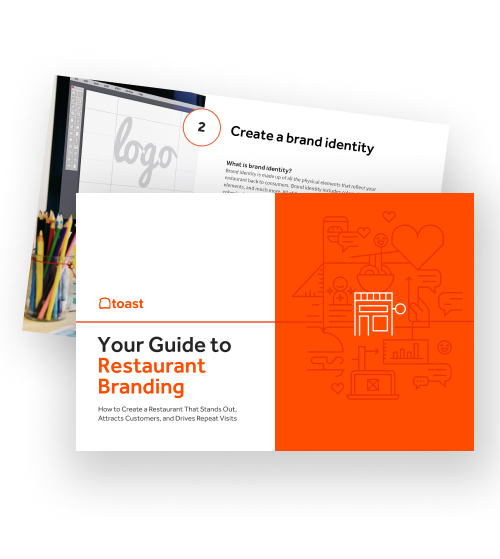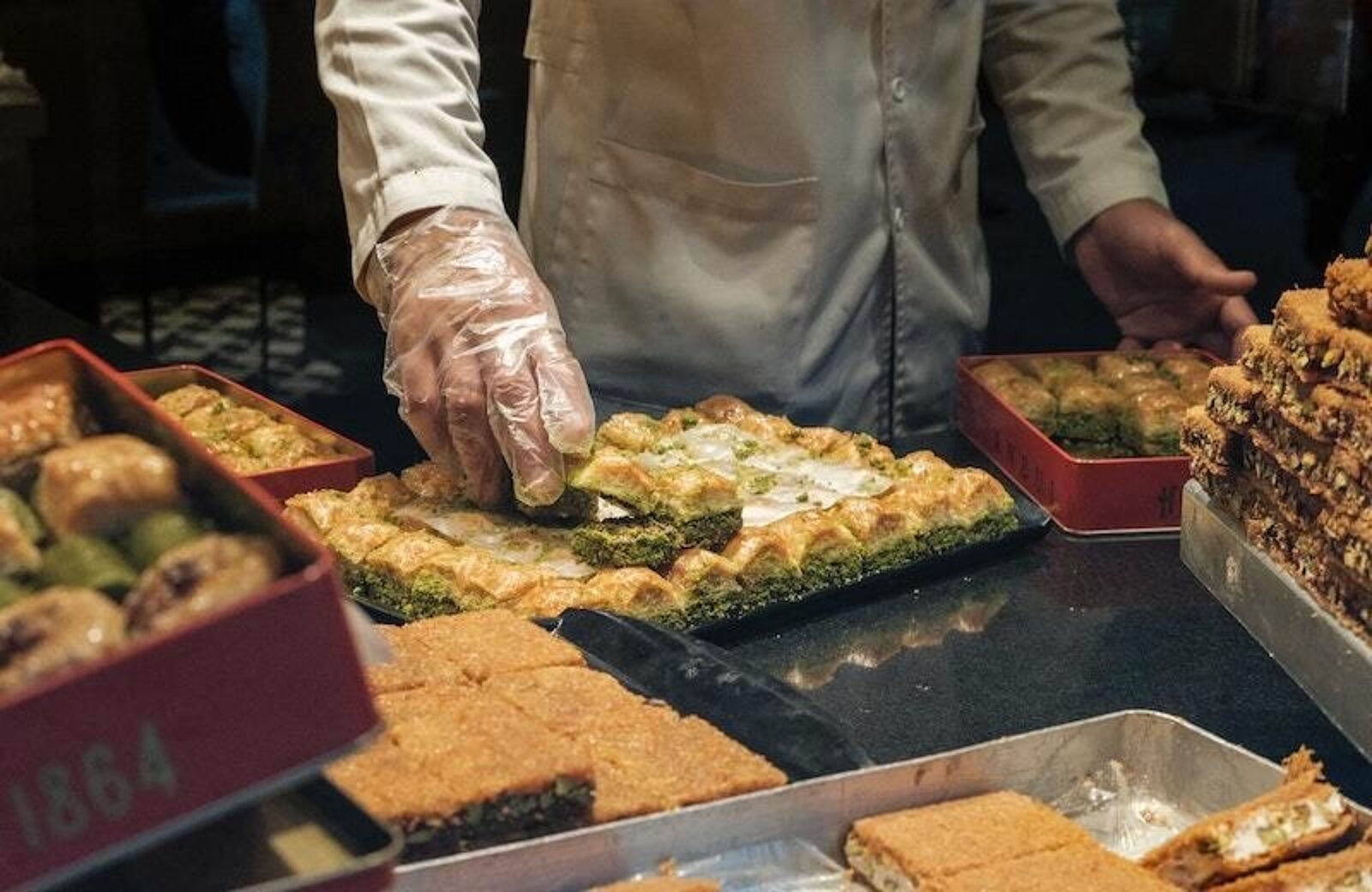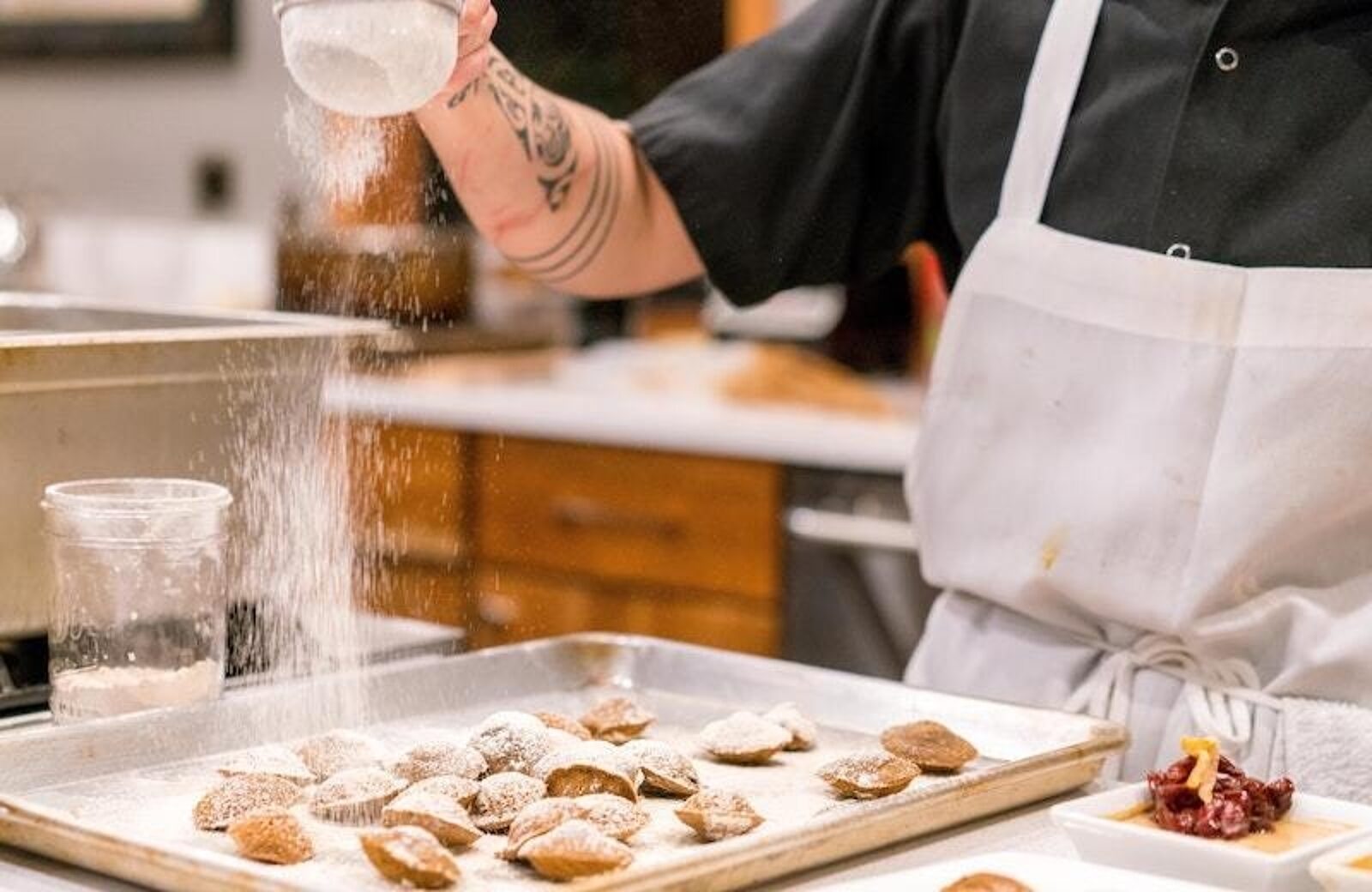
How to Do Bakery Branding (Ideas and Examples)
Learn how to build a bakery brand, with bakery branding ideas you can use as inspiration to help you to stand out from your competitors.

Katherine BoyarskyAuthor


The Ultimate Guide to Restaurant Branding
Use this guide to get tips on how to create a restaurant brand that stands out, attracts customers, and drives repeat visits.
Get free downloadHow to Brand a Bakery
There are almost 7,000 commercial bakeries in the U.S. Add to that the coffee shops, cafes, etc. that serve pastries and other baked goods, and your spot faces competition as stiff as the peaks on your meringue cookies. So how can you attract customers to your new bakery and turn them into bonafide fans, like Boston’s Flour Bakery, did? The answer is strong branding.
Bakery branding is more than just a cute logo and catchy name. Building a solid foundation early on will keep bringing customers through the door.
Establishing solid restaurant branding takes time and consistency, and leads to a sustainable bakery business with loyal customers.
The Ultimate Guide to Restaurant Branding
Use this guide to get tips on how to create a restaurant brand that stands out, attracts customers, and drives repeat visits.

How do you brand a bakery?
Your branding helps to establish a positive perception of your business in the minds of potential customers. People come to know who you are and what they can expect from you and your baked goods.
Strong branding shapes the emotional connection that customers have with you, and sets you apart from your competitors. You’re no longer just another local bakery — your business becomes defined by your vision, values, and goals. As soon as people connect with you, they get a feel for who you are as a business, and what you stand for.
Your bakery brand is essentially a blueprint for your business. It’s the story that connects you to your customers.
Ways to develop a bakery brand
- Open your bakery with a mission in mind.
- Identify your USP (unique selling point) and who your competitors are.
- Define your brand voice for your bakery.
- Create a consistent brand image with visuals, including color palette, logo, and design.
- Continually test new ideas as your brand evolves.
Your branding should align with all of your restaurant marketing elements, including your logo, website, posters, takeout boxes, and signage. With a positive brand image, customers are more likely to keep coming back to you. This is known as brand loyalty. And with brand loyalty comes word of mouth, or your own customers spreading awareness of your business.
For any type of eatery this can be challenging, as customers have different tastes and preferences. For bakeries, brand loyalty is key to building a financially successful business. Think about some brands that you’re loyal to. What are the reasons that you keep purchasing from them? Their strong branding may be associated with it.
For example, McDonald’s is the top fast food restaurant in the US in terms of sales, yet it regularly ranks in consumer polls as having the worst customer service in the fast food industry. Why? They have a strong, instantly recognizable brand that keeps people going back again and again. Of course, this type of branding takes time (and millions of dollars). So how can you begin to build your own foundations to grow a unique bakery brand? Let’s take a look.
Restaurant Marketing Plan
Create a marketing plan that'll drive repeat business with this customizable marketing playbook template and interactive calendar.

5 Steps to Building your Bakery Brand
1. Clearly define a bakery mission statement.
Your mission statement should define your purpose and communicate your brand’s unique personality. It should be simple and concise, but also reflect every part of your business, from your food quality to the service you provide to your community.
Sound like a tall order? Don’t worry, we have some tips to get you started.
When crafting your mission statement, consider who your target customers are, why you wish to serve them, the kind of service you promise to give them, and how your goals align with theirs.
Once you start to create your mission statement, your overall brand story will become clearer. To write your mission statement, think about:
- What your business does
- Why it does what it does
- What your goals are
- How you’re going to achieve these goals
The answers to these will help you to determine your USP, helping you to distinguish yourself from your competitors. Continue to refine your statement until you get a short, concise paragraph.
Examples of bakery mission statements:
“One Panera for a healthier and happier world.” Panera Bread
“At Wildflour Bakery we are committed to crafting high quality artisan baked goods with the freshest, all-natural ingredients. We aim to respect the integrity of the foods available to us through seasonal specials, made from scratch methods of production with a commitment to our local food economy.” Wildflour Bakery
“A specialty coffee shop serving quality food, wine, and beer… A gathering place for entrepreneurs to meet over coffee, friends to catch up over a glass of wine, and everything in between.” Rosella Cafe
2. Position your bakery in the market.
Once you’ve established your mission statement, it’s time to position your bakery in the market. Brand positioning helps you to communicate who you are to your customers. You’re able to communicate your value, justify your pricing strategy, and differentiate yourself from the competition.
Use the four Ps to establish your bakery brand positioning.
How to Position Your Bakery Brand
- Product — this includes the baked goods that you’re offering to customers (your bakery menu), your bakery theme or concept, and the type of brand experience you’ll provide.
- Price — your bakery menu pricing strategy helps define who your competition is. Are you going to offer competitively priced goods, or are you providing a luxe baked goods menu?
- Promotion — this is how you are going to market your bakery to potential customers.
- Place — this is how you’re going to deliver your menu to your customers. Will you have a physical store? A food truck? Specialize in delivery?
Branding tip: You can survey your potential customers to determine who your competitors are. From here, you’ll be able to establish what your bakery brings to the table, aligning your position to your overall experience. For instance, your brand may be viewed as a market leader, good value for money, premium, or a challenger for leading your market.
3. Establish your brand voice.
Simply put, your brand voice is your personality in writing. Along with the visual aspects of your bakery, your voice will define your overall brand identity.
One way to establish your brand voice is to think of your bakery as a person. How would you describe this person in three words? Here are some words you could use:
- Friendly
- Fun
- Passionate
- Down-to-earth
- Positive
- Trustworthy
- Reliable
- Enthusiastic
- Authoritative
- Eclectic
- Heartfelt
- Sympathetic
Once you have three descriptive words, expand on each. For example, if you describe your bakery as friendly, what makes it so? Is it your customer service? The target customers you hope to attract? Once you establish the answers, you’ll have a better understanding of your brand personality to convey through your voice.
4. Create your visual identity.
The visual identity of your bakery is more than just the logo or brand colors — it’s the overall look and feel of your brand. The design of your store, along with your packaging, menus, and signage, should be memorable and cohesive. Remember, this is all about making a good first impression.
To create your visual identity, begin by building the foundations of your branding. Create a mood board of aesthetic elements you like, such as colors, logos, and bakery designs. You can give this to a designer or use it as inspiration as you build all elements of your branding.
5. Make a brand book for your bakery.
Successful branding of any business starts with consistency. Anytime a customer interacts with your bakery brand, whether they’re on social media, looking at a menu at your store, or on your website, they should have a similar brand experience.
Brand books outline all your branding elements, including your voice, visual identity, mission statement, and positioning.
They also serve as a manual for your team. Onboarding new employees will be much easier if you have a brand book to lean on.
Your brand book can include:
- Your brand colors and fonts that are used across your business, including your posters, packaging, social media, and more.
- Photographs for use in your marketing materials.
- Your communication style and brand language.
- An outline of your brand story.
Examples of Successful Bakery Branding Ideas
Now that we’ve talked about building a bakery brand, here are some of the brands that we know and love. Take a look at these bakery branding ideas and see how they’re successful in communicating their brand to their customers.
1. Flour Bakery
How could you not be happy when looking at the color yellow? The branding for Flour Bakery features bright, cheerful colors that are consistent across their brand. Their friendly, playful brand voice is apparent from the words on their website, especially as they “want each customer’s experience to be full of delight”.
Make sure your color scheme and logo is communicated across your whole brand.
2. Hound and Mare
Hound and Mare has a soft pink color palette, which is consistent from their logo to their social media images. In color psychology, pink is associated with calm, compassion, and positivity. The brand name Hound and Mare comes from the founder’s zodiac animals. Notice how their brand voice matches their color tone, in imparting a friendly yet approachable feel.
Make sure your graphic and font choices fit with what your bakery brand is trying to convey.
3. Sunmerry Bakery
Sunmerry Bakery’s branding is playful, which you can see clearly from this graphic. They’re celebrating the year of the Tiger with a recent addition to their menu—another great marketing tactic that aligns with their Asian backgrounds.
When you are planning your menu, think about how you can tie them into your story or vision. This is an effective way to ensure your branding is cohesive and personal.
4. Skaneateles Bakery
Skaneateles Bakery's minimalist, retro approach to their branding ties into their mission of ‘celebrating the simple pleasures’. The bakery presents a down-to-earth, friendly feel that endears them to their community.
Don’t be afraid to opt for minimalist branding if it fits with your values.
5. Bouchon Bakery
Bouchon Bakery’s French influences can be seen in their earth-toned green and brown color scheme, which is often used in country house interiors within France. The brand fonts and design elements are also regularly used in French bakery branding.
When choosing your branding, think about how each aspect ties in with your own influences, back story, and vision. Elements that align create a bigger impact by emphasizing your brand identity.
When it comes to bakery branding, bake it till you make it
Branding is important for shaping a customer’s perception of your business. It affects purchasing behavior by helping people to identify a business, their products, and their individuality. Strong branding creates familiarity, helping to attract and retain customers.
By showcasing your brand across your physical location, menu, packaging, and digital presence, you actively demonstrate your mission and values. With time, you’ll be able to build on these foundations to create a positive image, credibility, and trust that leads to loyal customers who can’t get enough of your brand.
To learn more about building a brand that excites, download our free Restaurant Branding Guide today.
Related Bakery Resources
The Ultimate Guide to Restaurant Branding
Use this guide to get tips on how to create a restaurant brand that stands out, attracts customers, and drives repeat visits.

Is this article helpful?
DISCLAIMER: This information is provided for general informational purposes only, and publication does not constitute an endorsement. Toast does not warrant the accuracy or completeness of any information, text, graphics, links, or other items contained within this content. Toast does not guarantee you will achieve any specific results if you follow any advice herein. It may be advisable for you to consult with a professional such as a lawyer, accountant, or business advisor for advice specific to your situation.
Read More
Subscribe to On the Line
Sign up to get industry intel, advice, tools, and honest takes from real people tackling their restaurants’ greatest challenges.



